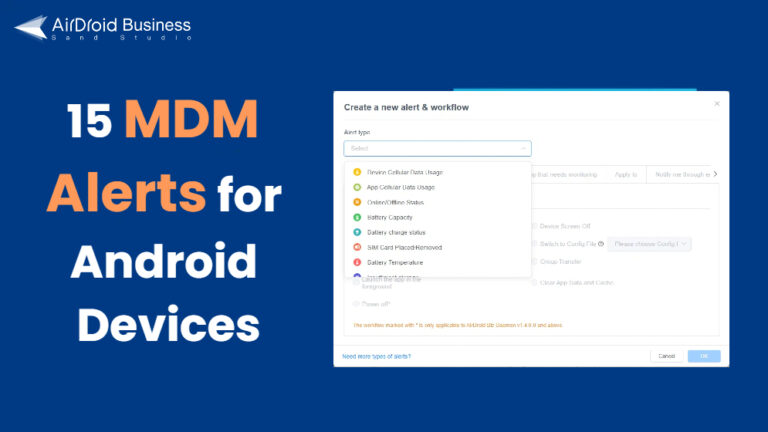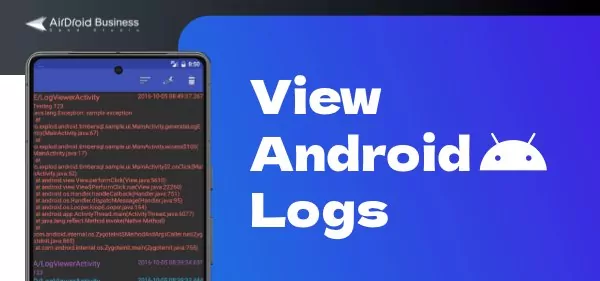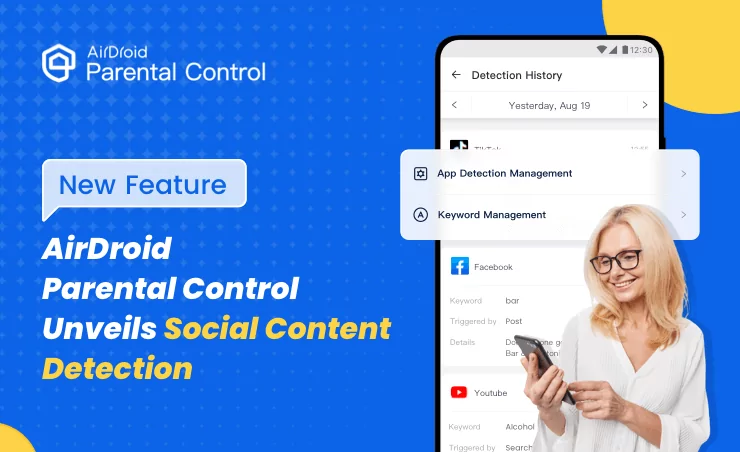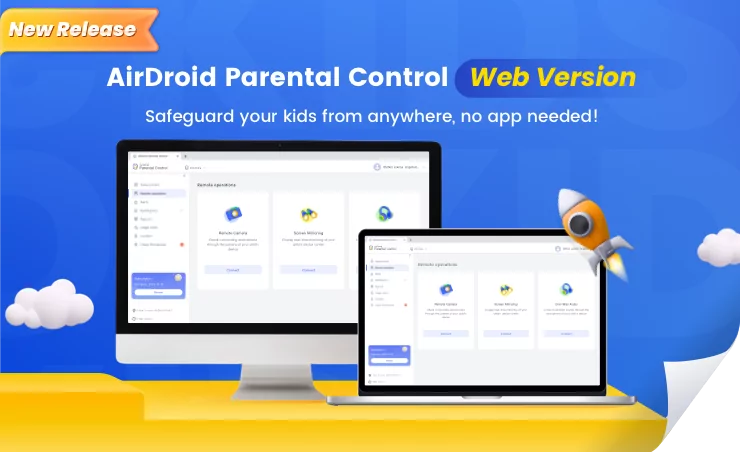Top 15 MDM Alerts to Enhance Android Device Security
With huge fleets of enterprise devices at scattered locations, it is almost humanly impossible to monitor each one of them all the time and ensure device and data security. However, with a comprehensive MDM solution that provides proactive monitoring, ensuring optimal device performance and impeccable security is as easy as a breeze.
These MDM solutions, like AirDroid Business, let you set workflows and alerts for all the metrics that matter. So, you don’t need to stick to the dashboard screen to stay aware of how each device is performing. In this article, we’ll explore some of the most useful MDM alerts and workflows that can help you increase productivity, avoid downtime, and ensure security.

Let’s start by understanding what MDM alerts are and how they can help your business.
1What Are MDM Alerts?
These are the notifications that are set for various metrics related to enterprise devices. Once you have set these alerts, you will automatically get notifications for those metrics. For example, if you have set notifications for battery performance, you’ll get notified every time the battery drops below a set level. This way, there’s no need to manually monitor the status for each device or refresh it every now and then.
2Why are MDM Alerts So Important for Business?
These alerts have innumerable benefits for businesses as they promptly inform admins about security compliance violations and operational issues. Hence, these alerts can be used for immediate action to counter any issue. Here is how they help enterprises:
Real Time Monitoring
Threats are detected in real time when you have set alerts for them, and hence, prompt actions can be taken. You cannot actively look for threats all the time for each one of the devices, hence, you need these alerts for automatic real-time threat detection.
Prompt Actions
Actions like remote wiping, locking, updating, etc., can be performed immediately in response to the alerts. This helps avoid downtime and security breaches.
Ensuring Policy Compliance
Whenever a device user violates the company’s policies, e.g., installs unapproved apps or changes security settings, admins are notified.
Avoiding Downtime
Through the real-time monitoring of device status, you stay in the know of how each device is performing. Any performance-related issues are immediately reported and dealt with, hence avoiding downtime.
In short, a comprehensive MDM solution allows proactive monitoring of your enterprise’s entire fleet of devices, helping you avoid any performance-related or security issues and ensure compliance with industry standards.
However, selecting the right types of alerts is crucial for wholesome monitoring. Let us explore some of the most commonly used workflows and alerts offered by AirDroid Business to help you stay informed.
315 Types of MDM Alerts and Workflows of AirDroid Business
AirDroid Business is a wholesome and comprehensive Mobile Device Management solution that offers remote support for enterprises and helps them proactively monitor and manage their devices from a centralized dashboard. Through its various workflows and alert options, AirDroid Business allows admins to stay informed about the real-time status of devices and how they are being used.
Given below are 15 examples of some useful alerts that you can set using AirDroid Business and make sure you never miss an important update that needs action.
15 MDM Alerts
- Device Cellular Data Usage: Notifies when a device reaches allowed data usage. High usage may indicate malware attacks, unauthorized app downloads, or data theft.
- App Cellular Data Usage: Identifies which apps consume most data, preventing extra costs and ensuring no unauthorized app usage.
- Online/Offline Status: Alerts when unattended devices go offline, allowing prompt action to reduce downtime.
- Battery Capacity: Tracks battery capacity to allocate devices appropriately and troubleshoot issues proactively.
- Battery Charged Status: Monitors battery levels to ensure devices don't run out of power during critical operations.
- SIM Card Placed/Removed: Notifies when SIM cards are swapped, ensuring devices use authorized SIMs only.
- Battery Temperature: Alerts when battery temperature rises, preventing damage from overheating.
- Insufficient Storage: Informs about low storage, allowing actions like switching to cloud storage or clearing cache.
- App Running Status: Monitors app performance to ensure smooth operation and timely updates.
- Foreground App Status: Ensures specific apps run in the foreground, crucial for single-purpose devices.
- Biz Daemon Permission: Warns about unauthorized access attempts to core services, ensuring security.
- Device Motion Status: Also known as geofence alert, it ensures devices operate within authorized locations.
- Kiosk: Notifies attempts to disable kiosk mode on customer-facing devices.
- Screen Lock: Allows remote screen locking based on preset notifications to save battery and ensure security.
- External HDMI Status: Alerts about HDMI connections, preventing unauthorized screen sharing or ensuring proper connection.
3Case Studies: How Enterprises Use MDM Alert Solutions

In order to understand the practical application of these alerts and how they work as a savior in virtually every industry, below are some case studies where businesses were able to solve crucial problems using MDM alerts by AirDroid Business.
1Logistics Industry: X Logistics Company (battery and equipment failure alarm)
Overview
X Logistics Company provides logistics facilities across various cities. They have equipped their drivers with Android devices for navigation and processing orders.
Challenges
The company had its devices scattered across the country, and it couldn’t manually monitor all devices to learn about their real-time status. This often led to battery failure, causing disruptions and downtime.
Solutions
The logistics company decided to rely on AirDroid Business for automated alerts whenever a device needs attention. They set up the following 2 types of alerts for timely warnings:
- Battery Level: Configured alerts for low battery level and set the parameter to 20%. Drivers are notified to charge their devices.
- Device Malfunction Alerts: Notifications are sent to admins for abnormal device behavior, allowing remote diagnosis and troubleshooting.
Results
As a result of prompt alerts, the company was able to reduce downtime caused by device failure and low battery by 30%. This improved driver satisfaction and reduced overall maintenance costs.
2Retail industry: Y retail chain (application usage and security policy alerts)

Overview
Y Retail Chain has set up a number of kiosks in its stores, used to run retail applications for customers.
Challenges
The company struggles with keeping the usage of kiosk tablets limited to authorized apps. Unauthorized app usage disrupted normal business operations.
Solutions
The company set up the following alerts provided by AirDroid MDM:
- Unauthorized App Usage Alert: Alerts are sent immediately when kiosk tablets exit kiosk mode or run unauthorized apps.
- Network Interruptions Alert: Alerts are triggered for abnormal network connections, notifying admins at headquarters.
Results
Almost 40% of the time normally spent on manual troubleshooting was saved. Customers received an uninterrupted retail experience, and ads played without disruptions.
3Healthcare industry: rehabilitation centers (patient-side alerts on equipment use and health status)

Overview
A prominent healthcare provider used tablets at various hospital locations for maintaining patient records and conducting video therapies.
Challenges
Monitoring devices in real-time and ensuring their operational status was difficult. Unauthorized use and network issues disrupted operations.
Solutions
The hospital configured alerts using AirDroid Business for timely notifications and prompt action:
- Remote Device Status Alerts: Prompt notifications for critically low battery and network disruptions.
- Application Behaviour Alert: Notifications for unauthorized app usage, enforcing device restriction policies.
Results
The hospital restricted unauthorized device use, and remote lock and policy enforcement ensured devices were used for intended purposes. Prompt notifications allowed remote troubleshooting without manual intervention.












Leave a Reply.